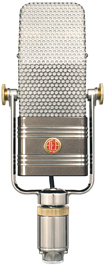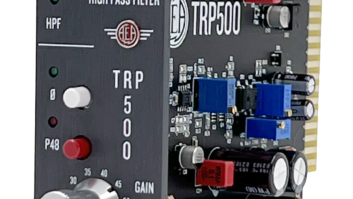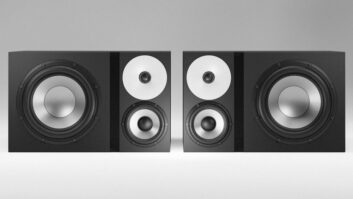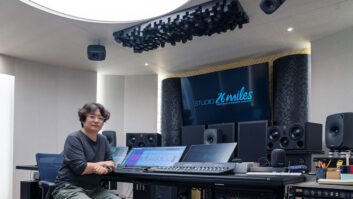

Audio Engineering Associates’ Wes Dooley has released another remarkable ribbon transducer in the A440 ($5,800). This “long ribbon” figure-8-patterned mic is based on the RCA 44, which was discontinued in 1955 after 23 years of production.
The A440 comes in a foam-lined soft case with a sturdy handle that keeps the mic in the preferred upright position for storage. This mic is no lightweight in any sense of the word: It weighs in at seven pounds and is more than one foot tall, 4.6 inches wide and 3.3 inches deep. The 2.35-inch, pure-aluminum ribbon is 0.185 inches wide and 1.8 µm thick. The A440 comes with a sturdy, attached 9-foot cable that terminates in a standard XLR. You can even take advantage of custom color, mic flag and tuning options.
Taking the A440 more than one step beyond the original, this new model is an extremely quiet, high-output, phantom-powered transducer. With a noise floor of only 6 dB(A), the signal-to-noise is an impressive 88 dB (94dB SPL minus equivalent noise), and its dynamic range is better than 127 dB. Frequency response is the classic 44 curve with solid bass down to 20 Hz and useful treble out beyond 20 kHz.
FIRST IMPRESSIONS
Can I say “love at first sight” in a product review? Sure, why not, because that was literally the impression of everyone who saw the A440 up close. It is hefty, well crafted and impressive. This is a mic you can’t wait to put up on anything that makes sound: It brings out the fun factor, big-time. Not only does it look good, but it also performs quite ably in the sonic department.
The first test was on a male vocal, an especially strident vocalist whose pipes crave the tonal taming of a dynamic mic. A condenser is just too revealing for this singer. (For examples, listen to the Online Extra sound clips at mixonline.com.) I placed the singer in front of the mic and quickly realized that the proximity effect is greatly magnified with the A440 — the closer you get, the more the bottom end blooms. So I employed a pop filter to stop the plosives and established a proximity standard. The optimal distance seemed to be three inches, which provided plenty of bottom end, and smooth mid-frequencies and top end. Overall, the balance in the track was perfect and I could play with the bottom end even more by compressing the vocal using the SSL 4000’s channel compressor set to slow attack and a 3:1 ratio, compressing about 8 to 10 dB at the peaks. This tamed the voice’s edge, and a beautiful, warm low-end presence came through. I should mention that as I expected, little gain was needed to get the mic’s perfect level to Pro Tools, and it was whisper-quiet.
When placed about a foot in front of the f-hole on an upright bass, the AEA proved to be one of the best mics I’ve ever heard in this application. I generally place the mic lower on the instrument, pointing up to where the player is plucking the strings to capture the lower frequencies, but that wasn’t necessary in this application. The balance was perfect between the sound of the fingers on the strings, and the full and round bottom end of the instrument. The part called for pizzicato and bowed parts, and the A440 captured both quite well.
When used 12 inches outside of a kick drum with a pop filter in front to protect the engine, the A440 sounded great paired with a Beyerdynamic M88 on the inside of the drum. It had the effect of a sledgehammer to the chest that would please any engineer. However, later in the day on the same kit, it didn’t fare as well when paired with a Sennheiser e604.
Using the A440 on acoustic guitar proved a most revealing test. With cues from the control room, I moved the mic around to find its sweet spot. The null point at the side of the mic is so strong that I could use it to “tune out” the guitar’s big bottom end by pointing the mic’s off-axis point toward the low end of the instrument and capture the pick on the strings perfectly on-axis. While the A440 wouldn’t be my first choice for this particular acoustic-guitar model, I wouldn’t hesitate to use it on an instrument that was sounding a bit thin.
FINDING BOTTOM
It didn’t take much effort to fall in love with the AEA A440, but like all good relationships, you’ve got to work at it. Placement is more critical with this mic than any other ribbon I’ve used. The A440 is a low-frequency magnet: It’s the mic of choice for upright bass, hands-down. On kick drum, it rocked as long as it was partnered with another mic to bring out the attack of the beater. It was great on trombone and tuba, and even sounded good on acoustic guitar.
The A440 is pricey, but well worth it if you’re looking for a unique-sounding niche microphone that can reliably take on more than 130 dB of SPL and deliver plenty of bottom end.
AEA Microphones, 626/798-9128, www.ribbonmics.com.








